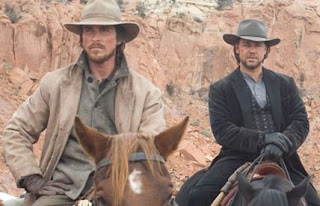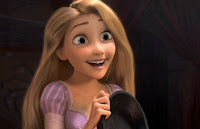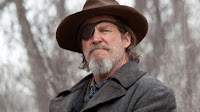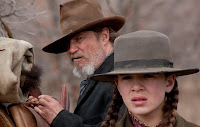"It All Ends Here"
Such is the tagline for the final movie installment of the Harry Potter movie franchise. An unforgettable cinematic journey that began in 2001 has now reached a bittersweet but satisfying end ten magical years later. Tears have been shed, roads have been traveled, lives have been lost, and the great battle between good and evil is finally coming to the ultimate climax that has been building for seven movies. Harry Potter and Lord Voldemort will face off at last, but the conflict has escalated to stakes far greater than personal grievances-- the future of the entire wizarding world hinges on the outcome of this final definitive showdown.
The Deathly Hallows Part Two picks up where Part One left off, with possibly mere moments in between. Harry, Ron, and Hermione have just barely dried the tears from their eyes before they must turn their faces to the next task and continue the horcrux hunt. With very little to go on, the trio set off again on another impossibly risky quest, just hoping they find what they are looking for. Their adventures will take them from the soothing seaside to the dark and damp vaults of Gringotts, and eventually all the way back to the hallowed halls of Hogwarts.
The simpler more fantastic times of The Sorcerer’s Stone were so long ago they barely seem to be part of the same timeline anymore, but after ten years of growing and changing, The Deathly Hallows Part Two is an appropriate contrast to the earlier years of Harry Potter, thoroughly showing how much has changed in the characters and their world. This monumental finale tastefully manages to conjure an impressive mixture of amazement and tender sweetness into the ubiquitous solemnity of the film’s general aura. Moments of extreme intensity are relieved by well-timed comic relief, without distracting from the severity of the situations at hand. The few moments that are not laden with mortal peril are used wisely to secure the copious emotions of the moment and effectively build to the grand battle scenes.
The Deathly Hallows Part 2 is by far the most action-packed movie of the saga, but by no means overwhelming the main points of the story. In true wartime fashion, the characters (and by extension the audience) are barely given ample time to truly understand the losses they have felt, let alone grieve over them. Although the character casualties are relatively high for a story of its kind, the deaths seen onscreen are mostly villains which carries a certain balance of pros and cons. It is positive to the degree that it sells the triumphs and victories over the evil forces (one particularly intense scene featuring a horde of snatchers and a bridge comes to mind), bringing with it the satisfaction of seeing tormenters and ne'er-do-wells get their long-belated due. Indeed the villains are disintegrated, vaporized, frozen in mid-air and then wrenched out of high heights, fall in crumbling structures, and decapitated.

It is very mildly negative in the way that none of the casualties from Harry's side of the war are given the kind of emotional sendoff that we experienced in the case of Dobby, Dumbledore, Sirius, or even Cedric (though admittedly this would have been difficult to pull off and might have completely ruined the pacing). (Spoiler Warning) The exception to this is Snape's heart-wrenching death scene. When the camera takes us into the great hall where the valiant fallen have been lain, there are but a few seconds to process the gravity of the losses before the story must move on. Exiting the theater it was clear that some of the non-readers were unsure of which Weasley twin had fallen in battle, since the subject's face is not clearly shown and his name is only briefly mentioned, though it is clear that the one of the twins now lay lifeless on the stone floor with the remaining Weasleys mourning him.
The numerous action and battle scenes are the most excellent to ever be seen in a Harry Potter movie, from the grand dragon escape from the vaults of Gringotts to the battle of Hogwarts to the final confrontation, everyone receives ample use of their wands. What is especially noteworthy about the action of the film is how each sequence manages to be entirely unique and not repeat itself in terms of method. The intensity of escaping Gringotts on a dragon is entirely different from the inferno in the Room of Requirement, which is in turn different from the Battle of Hogwarts and the last duel between Harry and Voldemort and the cut shots in between of other characters in individual conflicts.

Each battle or action scene is executed with effective intensity and passion. The dark side’s legion of Death Eaters, mass of unruly giants (and not the loving half-breeds like Hagrid), as well as massive spiders of the dark forest (previously seen in The Chamber of Secrets), as well as Dementors (first seen in The Prisoner of Azkaban) and the werewolf who claims the life of a minor character from a previous film are the steel backbone of the action. Not only because they are the antagonists and “the dark side”, but because they fight without even a convoluted moral center, and are therefore appropriately formidable.
While there are many performances of The Deathly Hallows Part Two worthy of mention, there are undeniable standouts among the fantastic cast. Although each of the main characters of the trio all turn in pristine performances, they are most definitely upstaged by the supporting cast that boasts some of British cinema’s finest veterans. The characters of Harry, Ron, and Hermione are firmly established by this point and so their development is fairly complete (see Harry Potter and the Deathly Hallows Part One review), with some strong moments thrown in, such as Harry’s reaction to Snape’s demise and his subsequent realization of what he must do to end the conflict once and for all.
 The minor supporting cast delivers its own set of pungent and memorable moments, the best nominations of which are Warwick Davis as Griphook, and the always fabulous Jason Isaacs as Lucius Malfoy. While Griphook may not feature as a particularly important character, Davis captures the goblin’s conniving and treacherous nature with absolute perfection. The goblin does not speak; he seethes his lines, each word as pointy and sharp as the goblin’s own teeth, dripping with imminent treachery.
The minor supporting cast delivers its own set of pungent and memorable moments, the best nominations of which are Warwick Davis as Griphook, and the always fabulous Jason Isaacs as Lucius Malfoy. While Griphook may not feature as a particularly important character, Davis captures the goblin’s conniving and treacherous nature with absolute perfection. The goblin does not speak; he seethes his lines, each word as pointy and sharp as the goblin’s own teeth, dripping with imminent treachery.
Too much good cannot be said of Lucius Malfoy’s peerless portrayal by Jason Isaacs. Once an aristocratic Death Eater and leader of the underground supporters of Lord Voldemort, Lucius is now an unrewarded diminished servant of the Dark Lord who has been dealt more than he bargained for when he chose his side. The demoted state of the Malfoy family is most apparent when Lord Voldemort himself asks Lucius with absolute disgust “How do you live with yourself?” The man who was once instrumental in the sinister plans of The Chamber of Secrets now cowers before the power he has pledged allegiance to, and eventually flees in terror, having finally comprehended the cost of his alliances. Before caving to cowardice, his own son will share in his disgrace and taste loss when he watches one of his friends die in a malicious blaze.
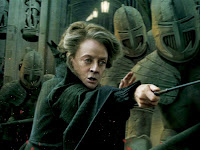 Turning to the major supporting cast, Maggie Smith as Minerva McGonagall finally gets her moment of glory, stepping into the foreground of the conflict after eight movies. At long last, the straight-laced Professor exhibits the strength and power that we have known was there all along. Fearlessly, McGonagall duels Snape and seizes control of Hogwarts in preparation for the impending attack. So seamless is Smith’s depiction that her lines ease from commanding to comical, never damaging the respect that her presence commands.
Turning to the major supporting cast, Maggie Smith as Minerva McGonagall finally gets her moment of glory, stepping into the foreground of the conflict after eight movies. At long last, the straight-laced Professor exhibits the strength and power that we have known was there all along. Fearlessly, McGonagall duels Snape and seizes control of Hogwarts in preparation for the impending attack. So seamless is Smith’s depiction that her lines ease from commanding to comical, never damaging the respect that her presence commands.
As the deputy headmistress of Hogwarts, McGonagall has always possessed a natural and incontestable authority that now shines forth when she summons an army of stone statues to defend the school. In the past, the staff of Hogwarts referred to the Dark Lord as “You-know-who”, but no more. “His name is Voldemort! You might as well use it; he’s going to try to kill you either way” McGonagall declares with sterling conviction. In the face of impossible odds, McGonagall steps forward in leading the battle of Hogwarts, displaying leadership and might in the hour of greatest need.
If anyone in the entire Harry Potter franchise deserves an Oscar, it is undoubtedly Alan Rickman. The character of Severus Snape in the hands of Alan Rickman has become the most mysterious and complex personality of all eight movies. As a character that has been present all along, Snape proves why in spite of being abrasive, antagonistic, and shady in his alliances, there was always a lingering feeling that he should be cheered for. The revelation of his back-story and history with a certain Potter family member is one of the most emotional arcs of the entire story, particularly a scene in which he appears at Godric’s Hollow shortly after James and Lily Potter have been murdered. The range of emotion Snape displays throughout the film is spectacular, from paralyzing grief to restrained horror to tender resolve, all shown immaculately.

In the moments leading up to Snape’s dramatic end, there is a clear but restrained fear in his eyes. As Voldemort speaks, Snape is aware of where the conversation is leading, but his hesitant manner suggests that he hopes his continued act will hold to the end. To his credit, he is never exposed to Voldemort as a traitor, but maintains his courage to the last minute, taking all the secrets of his true alliance with him to the grave. The emotion swells in his final scene as he lay looking at Harry with no more anger or hatred, allowing Harry to harvest Snape’s memories and taking in one last look at Harry’s eyes. By use of archive footage from the previous movies as well as a few additional scenes, every loose end about Snape is tied up neatly and completely, letting him die an unsung and misunderstood hero. At long last Snape’s greatest secrets are exposed, perhaps the most compelling of which is that he was truly good all along.
Lord Voldemort may have been a lingering presence and threat ever since The Sorcerer’s Stone, but Ralph Fiennes appropriately gets the most screen time in this final installment. Fiennes first appeared in The Goblet of Fire, but he has never owned his role so wholly and devotedly as he does here. Voldemort has always been dangerous, but here at the end of the grand saga, he rises to ultimate villain status through his sheer evil, stifled insecurities, and barely suppressed madness.
Although Voldemort believes himself to be the rightful ruler of the magical world (or the whole world), he does not appreciate opposition and at times seems almost overcome with insecurity at the idea that he does not have a unanimous following. After he extends an invitation to Harry to meet in the Dark Forest for an unconditional surrender, he paces slowly as if emotionally wounded by this snub, murmuring “I thought he’d come…” A few seconds later when Harry arrives, Voldemort’s elation is only apparent in the depth of expression in his eyes.
Ralph Fiennes exhibits the madness and chaotic evil of the Dark Lord with impeccable precision and chilling villainy. The Dark Lord’s mental instability is clearest when he deems himself victorious over Harry. He practically dances into Hogwarts laughing and proclaiming triumphantly that Harry Potter is dead with maniacal glee. Clearly he expects to have diminished all resistance, but when Neville Longbottom stands up to him, he can barely contain his fury. So he steps back, bites his lip and then responds condescendingly "I'm sure we all want to hear what you have to say." Each time that a horcrux is destroyed, Voldemort’s rage heightens, pushing him ever closer to the brink of insanity, but never quite tipping over the edge. The effect itself is mesmerizing and… maddening.

As a whole, Harry Potter and the Deathly Hallows Part Two does extremely well as a fantasy movie, with more moments that approach movie greatness than the few somewhat weaker moments and condensed explanations. In one especially impressive sequence, witches and wizards stand in the courtyard of Hogwarts casting protective spells skyward, forming a shield around the school. Music soaring, special effects perfect, and emotion peaking, this particular scene stands out as an example of one of the finest moments of the film. In another extremely pungent scene, Harry walks with Dumbledore in a celestial train station where he encounters a skinned and twitching fetus of the Dark Lord.
An example of weaker moments would be Harry and Voldemort’s final faceoff when the pair topples off a cliff, fly around unsteadily, and their faces meld momentarily before they skid to a halt in the school’s ruins. Because it is unclear what the purpose of this effect is, it comes across confusing and unimpressive. The rest of what should be the most defining fight of the saga between Harry and Voldemort is only acceptable, but not particularly memorable. Furthermore the long-anticipated demise of Bellatrix Lestrange may be appropriately swift, but there is barely enough time to register who Bellatrix has been fighting before Molly Weasley steps in to take the fight away from her daughter. On a minor side note, Julie Walters' delivery of the now famous line "Not my daughter you b****" was flawless. Elsewhere, when Harry is saying goodbye to Ron and Hermoine to go and face his own death, it seemed that emotion was lacking. Hermoine tearfully embraces Harry, while Ron does not even shake hands with this best friend. And finally, the Harry and Ginny romance has never truly hit the mark. This is partially a fault of the writers for not developing Ginny's character enough, but they also did not put enough of her in earlier movies to weave her through the story as a significant character. Ron and Hermoine have had eight movies of tension, nervousness, and jealousy. Without even a smidgeon of these elements except a few isolated moments in The Half Blood Prince, Harry and Ginny's involvement feels somewhat empty, even shallow.
Changes in casting, directors, and crew in the course of eight movies would spell certain doom for a lesser franchise, but Harry Potter used the differences in each movie to its advantage, bringing a diversity of vision and creativity instead of sticking to formula. The combined efforts from the leads and an excellent supporting cast, tasteful but marvelous use of special effects, and a perfect balance of magic and reality make Harry Potter and the Deathly Hallows Part Two the crown of the beautiful saga. The losses, the victories, and the long road of wonder and terror now at an end bring eight movies of outstanding quality to a satisfying, definitive, and happy finale.
